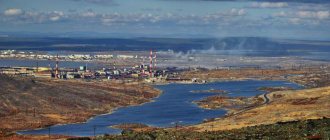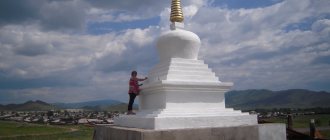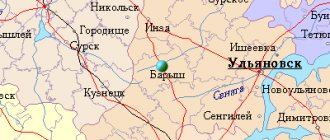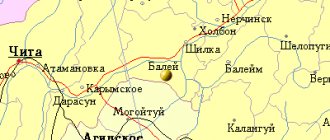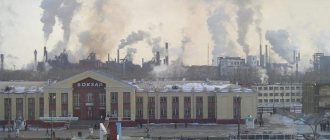| Coat of arms of Sudzha | |
| A country | Russia |
| Subject of the federation | Kursk region |
| Municipal district | Sudzhansky |
| First mention | 17th century |
| Telephone code | +7 47143 |
| Center height | 135 m |
| Population | ▼ 6,036[1] people (2010) |
| Timezone | UTC+4 |
| Postal codes | 307800 |
| Coordinates | Coordinates: 51°12′00″ N. w. 35°16′00″ E. long / 51.2° north w. 35.266667° E. d. (G) (O) (I)51°12′00″ n. w. 35°16′00″ E. long / 51.2° north w. 35.266667° E. d. (G) (O) (I) |
| Vehicle code | 46 |
| OKATO code | 38 240 501 |
Sudzha is a city in Russia, the administrative center of the Sudzhansky district of the Kursk region. Belongs to the historical region of Slobozhanshchina. Population (based on the results of the 2010 All-Russian Population Census) - 6,036 people.
Economy
- alcohol
- butter factory
- cereal factory
- building materials plant
- tractor units plant
- elevator
GIS Sudzha
The largest transit corridor for Russian gas supplies to Europe passes through the Sudzha gas measuring station, which consists of gas pipelines with a diameter of 1420 mm. GIS "Sudzha" allows you to supply 2.5 times more gas at the entrance to the Ukrainian gas transportation system than through all other export GIS combined. During the crisis of 2008-2009, the head of Naftogaz of Ukraine stated that it was impossible to export to Europe through Sudzha without cutting off gas supplies in three regions of Ukraine.
Modern Sudzha[ | ]
Park named after
M. S. Shchepkina Sudzha is a municipal entity within the Kursk region. The legislative body is the City Council, the executive body is the City Administration. In Sudzha there are local government bodies of the Municipal Formation "Sudzhansky District".
In Sudzha there is a music school, a music college, an agricultural technical school, and the Sudzhan branch of the Modern Humanitarian Academy. There is a clinic and a hospital, a sports complex, recreation parks, a cinema, a recreation center, and a regional museum of local lore (1962). The local history museum has a large collection of paintings by the artist P.K. Likhin, a native of Sudzha and a student of I.E. Repin. Two newspapers “ Sudzhanskiye Vesti”
" and "
Suji's Messenger
".
The amateur group Timonya
(village of Plekhovo, Sudzhansky district) is well known.
The international highway Kursk - Sudzha - Sumy bypasses the city. The St. Petersburg - Lgov - Sudzha - Kharkov railway runs near the city. The Gornal tract
preserved architectural monuments of the 18th-19th centuries: Trinity Church (Voznesenskaya, 1812); Church of the Nativity (1799-1828); Church of the Intercession of the Blessed Virgin Mary (1799-1828); near Sudzha, in the village. Zamosc and Zaoleshenka are the 5-domed churches of the 19th century. in Russian style; Palace of Prince Dolgorukov (ruins, architect V. A. Shchuko); monument to Russian actor M. S. Shchepkin (1895), etc.
Psel River (spit)
Natural monuments have been preserved in the Sudzhansky district: Cranberry Lake, Velikoye tract, Kreidyanka tract, Prince Dolgorukov Park in the village of Guevo, a 300-year-old pine tree, a natural monument of regional significance “Gornal tract”, etc. There are a large number of picturesque lakes, coniferous and mixed forests, chalk mountains (the most famous of them is Fagor).
Gornalsky St. Nicholas Belogorsky Monastery (founded in 1671, closed in 1788, reopened in 1863 and rebuilt in the Russian-Byzantine style). Since ancient times, a religious procession to Ukraine has been held from here with one of the shrines of the Kursk land, the miraculous icon of the Mother of God “Pryazhevskaya”.
Streets and squares[ | ]
List of Suji streets
[8]:
- May 1 (historical name - Arkhangelskaya
), - Volkova,
- Factory,
- Zalomova,
- Zarechnaya,
- Karl Liebknecht,
- Karl Marx (historical name - Sennaya
), - Komsomolskaya (historical name - Embankment
), - Krasnoarmeyskaya,
- Lenin (historical name - Kursk
), - Lomonosov,
- Lugovaya,
- Nekrasova,
- Oktyabrskaya,
- Pionerskaya,
- Privokzalnaya,
- Pushkin,
- Rose Luxemburg,
- State Farm,
- Construction,
- Chekhov,
- Shchepkina (historical name - Shchepkinskaya
), - Engels.
List of Suji lanes
[8]:
- 1st of May,
- Volkova,
- Factory,
- Karl Marx,
- Krasnoarmeysky,
- Nekrasova,
- Pionersky,
- Rose Luxemburg,
- Garden,
- Building.
List of Suji passages
[8]:
- 2nd passage,
- 3rd passage.
List of Suja squares
[8]:
- Privokzalnaya,
- Soviet (historical name - Sobornaya
).
Story
There was a human settlement on the site of the city until 1664, but after a big fire in 1662, an embassy of citizens was sent to Tsar Alexei Mikhailovich with a request to restore the settlement. The Emperor decided to build a fortress city here, because this was the height of the Russian-Polish War and the dramatic events in Ukraine (1654-1667). A city was built, surrounded by a wooden wall with 14 towers, 4 of which were roadways. Surrounded on all sides by swamps and rivers. In the city itself there was a Cossack hundred of the Sumy Cossack Regiment. At the height of the war with Poland, Sudzha was the center of its events. The troops of Voivode Romadanovsky arrived here from Moscow, the hetmans of Ukraine came here for negotiations, etc. After peace was concluded with Poland and Ukraine joined Russia, the city lost its military significance, but became one of the trading cities where the local merchants flourished. In the 18th century, Sudzha remained as a small trading city in the south of Russia. By decree of Catherine II in 1785, the city became a district center for the first time. Then its history and development freeze for many decades. Historical events pass through its lands, but do not change its appearance. Sudzha knows the era of great wars and revolutions. During the First World War, German troops appeared here; during the civil war, the city passed from hand to hand, being captured either by the Reds or by the armies of Denikin, Petlyura and even Father Makhno. The latter personally visited Suja. During the Great Patriotic War, this region was occupied by German troops and liberated on March 3, 1943. After the war, processing industry enterprises were created in the city - a butter factory, an elevator, a meat and poultry plant, a cannery and others. But they were small and could not radically change. But the good thing about the city is that the spirit of antiquity still lives in it. Legends about dashing robbers and mysterious ghosts, underground passages and miraculous icons are alive here. This is a living legend, a relic of our history. Artists L. I. Solomatkin, M. V. Nesterov, actor M. S. Shchepkin, aircraft designer M. I. Gurevich were born or lived in Sudzha at different times.
Geography[ | ]
The city is located on the southwestern spurs of the Central Russian Upland, on the banks of the rivers Sudzha (tributary of the Psel River) and Oleshnya (tributary of the Sudzha), 105 km from Kursk, 9 km from the border with Ukraine.
Climate[ | ]
The climate of the area is moderate continental.
Winter is moderately cold. The first half of winter is milder than the second, there are thaws. In January-February the weather is mostly frosty, with severe frosts possible. March is quite cold, climatic spring begins in early April. Summers are moderately humid and warm, with periods of intense heat and cool weather. Autumn is relatively warm. Climate Sudzhi
| Index | Jan. | Feb. | March | Apr. | May | June | July | Aug. | Sep. | Oct. | Nov. | Dec. | Year |
| Average maximum, °C | −4,4 | −3,4 | 1,7 | 12,4 | 20,1 | 23,4 | 24,7 | 24,0 | 18,3 | 10,8 | 2,9 | −1,5 | 10,8 |
| Average temperature, °C | −7,6 | −6,8 | −1,7 | 7,7 | 14,7 | 18,1 | 19,5 | 18,5 | 13,3 | 6,8 | 0,2 | −4,3 | 6,5 |
| Average minimum, °C | −10,8 | −10,2 | −5 | 3,1 | 9,3 | 12,8 | 14,3 | 13,1 | 8,3 | 2,8 | −2,4 | −7 | 1,9 |
| Precipitation rate | 43 | 32 | 34 | 40 | 50 | 70 | 76 | 59 | 52 | 46 | 47 | 49 | 598 |
brief information
Sudzha is a small town located in the southwest of the Kursk region, a regional center, the population of which with its suburbs is about 15 thousand people. The city is home to enterprises mainly in the processing industry, services and construction. Sudzha is one of the ancient cities of southern Russia. Its foundation dates back to 1664, although the historical monuments of this region go back to more ancient times. Thus, in the vicinity of the city in 1918 and 1936, famous treasures dating back to the 6th-9th centuries and of Byzantine origin were found. On the Psel River, 30 kilometers to the south, the remains of a fortified settlement from the Kievan Rus era have been preserved. 3 kilometers from the city, near the Knyazhiy farm, a human site dating back to the turn of the 1st century BC was discovered. e. There are also more ancient finds.
Add a comment
Comment
Send
Suja
(Kursk region)
OKATO code:
38240501
Founded:
17th century.
City from:
1664 City of district subordination (Sudzhansky district, Kursk region)
Center:
Sudzhansky district
Telephone code (reference phone)
| 47143***** | 21-508 |
Deviation from Moscow time, hours:
0
Geographic latitude:
51°12′
Geographic longitude:
35°16′
Altitude above sea level, meters:
135 Sunrise and sunset times in the city of Sudzha
Population[ | ]
| Population | ||||||
| 1856[9] | 1897[9] | 1913 | 1923[10] | 1931[9] | 1939[11] | 1959[12] |
| 4500 | ↗7400 | ↗12 800 | ↘3465 | ↗6900 | ↘3674 | ↗4004 |
| 1970[13] | 1979[14] | 1989[15] | 1992[9] | 1996[9] | 1998[9] | 2001[9] |
| ↗6197 | ↗7185 | ↗7487 | ↗7900 | ↗8000 | →8000 | ↘7700 |
| 2002[16] | 2003[9] | 2005[9] | 2006[9] | 2007[9] | 2009[17] | 2010[18] |
| ↘7045 | ↘7000 | ↘6800 | ↘6700 | →6700 | ↘6634 | ↘6036 |
| 2011[9] | 2012[19] | 2013[20] | 2014[21] | 2015[22] | 2016[23] | 2017[24] |
| ↘6000 | ↘5852 | ↘5762 | ↘5722 | ↘5684 | ↘5648 | ↗5738 |
| 2018[25] | 2019[26] | 2020[27] | 2021[1] | |||
| ↗5759 | ↘5657 | ↘5646 | ↘5554 | |||
As of January 1, 2022, in terms of population, the city was in 1057th place out of 1116[28]cities of the Russian Federation[29].
Literature[ | ]
- Tsapenko M. P.
On the western lands of Kursk and Belgorod - M., 1976. - “Refusal book for the newly built city of Sudzha, made by steward Gerasim Semyonovich Rogozin in 1664” translation by A. Dmitryukov - 1853.
- Matsulevich L. A.
Burial of a barbarian prince in Eastern Europe, - M.-L., 1934; - Rybakov B. A.
New Sudzhan treasure of the Antique period // “Brief reports on reports and field research of the Institute of the History of Material Culture” - 1949, century. 27. - A. I. Dmitryukov. Materials for the archaeological map of the Kursk district // Proceedings of the Kursk GUAC. T. 1. Kursk, 1911.
Notes[ | ]
- ↑ 123
The permanent population of the Russian Federation by municipalities as of January 1, 2022 (Russian). Retrieved April 27, 2022. Archived May 2, 2022. - Law of the Kursk Region of October 21, 2004 No. 48-ZKO “On municipalities of the Kursk Region”
- Moszyński K.
Pierwotny zasiąg języka prasłowiańskiego. - Wrocław-Kraków, 1957. - P. 189. - Ragozin G.S.
Inventory of the newly built city of Sudzhi. - 1664. - Demoscope Weekly - Application. Directory of statistical indicators
- ↑ 12
Liberation of cities: A guide to the liberation of cities during the Great Patriotic War of 1941-1945. / M. L. Dudarenko, Yu. G. Perechnev, V. T. Eliseev, etc. - M.: Voenizdat, 1985. - 598 p. - Red Army website. https://rkka.ru Archived copy dated September 30, 2022 on the Wayback Machine.
- ↑ 1234
List of streets in Sudzhi - ↑ 1 2 3 4 5 6 7 8 9 10 11 12
People's Encyclopedia “My City”.
Suja (undefined)
. Retrieved June 1, 2014. Archived June 1, 2014. - Kursk provincial statistical department. Population of the cities of Kursk province according to the censuses of 1920 and 1923. [Vol. 3]. - Kursk, 1927.
- All-Union Population Census of 1939. The size of the urban population of the USSR by urban settlements and intra-city areas (unspecified)
. Retrieved November 30, 2013. Archived November 30, 2013. - All-Union Population Census of 1959. The size of the urban population of the RSFSR, its territorial units, urban settlements and urban areas by gender (Russian). Demoscope Weekly. Access date: September 25, 2013. Archived April 28, 2013.
- All-Union Population Census of 1970 The size of the urban population of the RSFSR, its territorial units, urban settlements and urban areas by gender. (Russian). Demoscope Weekly. Access date: September 25, 2013. Archived April 28, 2013.
- All-Union Population Census of 1979 The size of the urban population of the RSFSR, its territorial units, urban settlements and urban areas by gender. (Russian). Demoscope Weekly. Access date: September 25, 2013. Archived April 28, 2013.
- All-Union population census of 1989. Urban population (undefined)
. Archived from the original on August 22, 2011. - All-Russian population census 2002. Volume. 1, table 4. Population of Russia, federal districts, constituent entities of the Russian Federation, districts, urban settlements, rural settlements - regional centers and rural settlements with a population of 3 thousand or more (unspecified)
. Archived from the original on February 3, 2012. - The size of the permanent population of the Russian Federation by cities, urban settlements and regions as of January 1, 2009 (unspecified)
. Retrieved January 2, 2014. Archived January 2, 2014. - All-Russian population census 2010. Volume 1. Number and distribution of the population of the Kursk region (unspecified)
. Retrieved January 31, 2014. Archived January 31, 2014. - Population of the Russian Federation by municipalities. Table 35. Estimated resident population as of January 1, 2012 (unspecified)
. Retrieved May 31, 2014. Archived May 31, 2014. - Population of the Russian Federation by municipalities as of January 1, 2013. - M.: Federal State Statistics Service Rosstat, 2013. - 528 p. (Table 33. Population of urban districts, municipal districts, urban and rural settlements, urban settlements, rural settlements) (undefined)
. Retrieved November 16, 2013. Archived November 16, 2013. - Table 33. Population of the Russian Federation by municipalities as of January 1, 2014 (unspecified)
. Access date: August 2, 2014. Archived August 2, 2014. - Population of the Russian Federation by municipalities as of January 1, 2015 (unspecified)
. Access date: August 6, 2015. Archived August 6, 2015. - Population of the Russian Federation by municipalities as of January 1, 2016 (Russian) (October 5, 2018). Retrieved May 15, 2022. Archived May 8, 2022.
- Population of the Russian Federation by municipalities as of January 1, 2022 (Russian) (July 31, 2017). Retrieved July 31, 2022. Archived July 31, 2022.
- Population of the Russian Federation by municipalities as of January 1, 2022 (Russian). Retrieved July 25, 2018. Archived July 26, 2022.
- Population of the Russian Federation by municipalities as of January 1, 2022 (Russian). Retrieved July 31, 2019. Archived May 2, 2022.
- Population of the Russian Federation by municipalities as of January 1, 2022 (Russian). Date accessed: October 17, 2022. Archived October 17, 2022.
- taking into account the cities of Crimea
- https://rosstat.gov.ru/storage/mediabank/bul_Chislen_nasel_MO-01-01-2021.rar Population of the Russian Federation by municipalities as of January 1, 2022 (1.85 Mb, 07/30/2021)
- The route through the Sudzha GIS is the main route to the Balkans - Gazprom (unspecified)
.
Economy
. RIA Novosti Ukraine (January 14, 2009). Access date: February 9, 2010. Archived February 9, 2012. - HONORABLE CITIZEN (undefined)
.
www.mke.su.
_ Access date: January 18, 2022.

